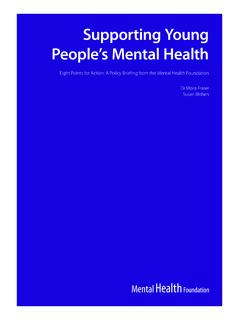Transcription of Late Adulthood
1 343 CHAPTER 9 late AdulthoodnOUTLINEPHYSICAL DEVELOPMENTDURING late Adulthood Physical development Health issuesCOGNITIVE DEVELOPMENTDURING LATEADULTHOOD Beyond Piaget s theory Information-processingduring late adulthoodSOCIAL AND EMOTIONALDEVELOPMENT DURING late Adulthood Emotional development Self and others Psychosocial development When does old age begin?Should this depend on chrono-logical age or a life event such as retirement from work?Although many people maintain that old age is a state ofmind, there are several life events that signal the beginningof late Adulthood . These are tied to chronology, just asother life events are in previous stages of the life sixty-five is considered a milestone and the begin-ning of late Adulthood . Reaching this age generally bringsabout retirement from work, eligibility for Social Securityand Medicare benefits, income tax advantages, reducedfares and admission prices to leisure events, and specialpurchase or discount privileges.
2 It is projected that by theyear 2020, approximately of the population will besixty-five years of age or older (up from in 1900, in 1950, and in 2000) (Himes, 2001). Thispercentage is expected to increase to by in modern medical care, better health prac-tices, improved nutrition, and other factors keep people inbetter health and living longer today (Himes, 2001). Forthese and other reasons, the period of late Adulthood canbe divided into five subcategories based on age by decade(Burnside, Ebersole & Monea, 1979). Please note that origi-nally there were only four subcategories; however, the cat-egory of centenarians has been added due to an increasingnumber of people living past one hundred. These subcate-gories are described below. Neugarten (1978) was amongthe first to recognize that not all individuals in late adult-hood are disabled or feeble.
3 These age divisions help tocreate a more realistic and positive impression of the eld-erly. Upon reading about them, you may conclude cor-rectly that late Adulthood comprises a diverse group ofindividuals. In this respect, it is like every other stage dis-cussed in this young -old (sixty to sixty-nine years): Societyexpects people in their sixties to have less energy,responsibility, and independence in Adulthood . Thisexpectation demoralizes people and serves as a self-ful-filling prophecy. True, physical strength declines fromearlier periods of the life span. Despite this limitation,many individuals in this age bracket are energetic, activein volunteer work, pursue hobbies and interests, leadvigorous lifestyles, and are in a state of good health(Kovar, 1986a, b; Kovar & LaCroix, 1987; Ries & Brown,1991).
4 Release from work and financial responsibilitiesgives them the chance to redirect their energies to activi-ties that please them. Self-improvement, sometimes evenin the form of entrance into college degree programs, isactively pursued by many people this middle-aged old (seventy to seventy-nine years):Losses characterize this decade. Deaths of spouses andfriends occur more frequently. Health problems become apreoccupation and restrict activities within and outside thehome, which can further shrink a person s social world. Asignificant challenge for people in their seventies is toretain the reintegration of personality accomplished fol-lowing old-old (eighty to eighty-nine years): People in thisage bracket find it increasingly difficult to adapt to theeffects of the advanced aging process. Housing and physi-cal space are often obstacles to effective living.
5 People intheir eighties become more preoccupied with their memo-ries and interested in relating their past living experiencesto others. Health problems become more frequent, severe,and of longer duration. Some people need to be cared forby others, which could be within a family member s home,a nursing home, or some other supervised living very old-old (ninety to ninety-nine years): Thereare far fewer people in this age bracket, so we have very lit-tle accurate information about them. Obviously, healthproblems play a central role in their lifestyles. People intheir nineties have very limited physical and social activity,but they appear to be happy, serene, and fulfilled(Bretschneider & McCoy, 1988).Centenarians (one hundred years and older): Cente-narians are a particularly hardy and diverse group of indi-viduals (Duenwald, 2003).
6 They are known for theirpositive dispositions and lower rates of chronic illness andage-related disabilities that plague their younger, elderlypeers. More women than men live to be one hundred;however, men tend to maintain greater health and many centenarians avoided smokingand obesity throughout life, others live to be one hundredor more despite suboptimal nutrition, little exercise, envi-ronmental toxins, and poor lifestyle choices (such as smok-ing). A few common themes among centenarians includeremaining emotionally close and involved with loved onesthroughout life, achieving financial security, and stayingmentally active ( , reading, writing, and cross word puz-zles). Such extreme longevity seems to run in families,hinting that genetics may play a role. Researchers hope toidentify the genetic factors that promote such longevity inorder to develop drugs that will mimic these genetic effectsin are more women than men in all of the sub-categories of late Adulthood (Himes, 2001).
7 This differ-ence is because men have higher mortality rates than344 CHAPTER9nLate Adulthoodnwomen throughout life. In general, for every one hun-dred girls born, one hundred and five boys are born (ofcourse, sex-selection during IVF or abortion can skewthese numbers). However, by the age of eighty-five thereis a 41:100 ratio that is for every one hundred women,there are only forty-one men. In general, women canexpect to outlive their are also some ethnic differences in terms of theelderly population (Himes, 2001). During the 2000census, 84% of all elderly people were white, non-Hispanic. However, it is projected that the elderlypopulation will become more ethnically diverse overthe next fifty years, with 64% of the elderly populationbeing considered white, non-Hispanic. It has beenspeculated that barriers to health care have con-tributed to earlier mortality rates for African Americanand Hispanic individuals.
8 Improved access to healthcare, fertility rates, and immigration will all play a rolein the increased diversity of the elderly population inthe years to DEVELOPMENT DURING late Adulthood ALEARNING physical development during late of health issues in late adulthoodPHYSICAL DEVELOPMENTThe vast majority of physical changes observed during late Adulthood are closely related tothe process of advanced aging. Physical functioning and daily activities are curtailed as theorgan systems degenerate. Many of the symptoms of organ degeneration appear promi-nently in middle Adulthood , but they become even more pronounced as people progressthrough late aging process in late Adulthood is termed senescence. The general effects of agingcombine to make the body s organ systems work less efficiently. For quite a while, peoplecan compensate for the declining efficiency of their organs and the body in general, butthe decline becomes dramatic later in this stage.
9 The discussion of theories of aging in chaptereight indicated that various causes havebeen proposed for aging in human beings. Although no one factor has been identified asbeing solely responsible for the aging process, researchers note that changes in collagencloselyparallel changes throughout the body and are associated with the aging process (Spence &Mason, 1987; Timiras, 1972). Collagen, a fibrous protein that is a basic component of con-nective tissue, is found throughout the body. It is characterized as a large molecule having CHAPTER9nLate Adulthood345nnSenescenceThe process of fibrous protein thatis a basic componentof connective properties. The flexible nature of collagen allows muscles, blood vessels, tendons, andother organs to transmit tension and experience compression without becoming would not be able to move about in a normal way without this important effects of aging may be closely related to the loss of collagen s elastic can be observed throughout the body.
10 Calcium salts, for example, begin to bedeposited in tissues as people advance in age during middle and late Adulthood . This sub-stance contributes to arteriosclerosis or hardening of the arteries, a condition that causeshypertension, related circulatory system disorders, and eventually death. Collagen changesin heart muscle tissue reduce the ability of this organ to perform in Weight and HeightThe loss of weight in men that begins in middle Adulthood continues through late adult-hood. Elderly women begin to lose weight in gradual increments during this physical activity, less food consumption, lower metabolism, poorer health, andrelated factors result in a reduction of muscle and tissue mass and hence in weight also continue into late Adulthood for both men and women (Abra-ham, 1979; Hegner, 1991). This loss in height is caused by compression of the spinal columnand the softening of muscle and bone tissue.



